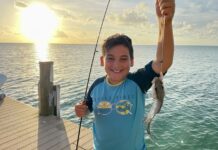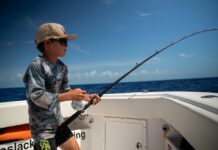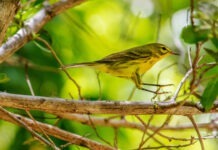The name bunting comes from a Scottish word that basically means plump. That seems judgmental. If they are plump, they are pleasingly plump, and no one talks about their shape anyway.
What we talk about when we talk about buntings is the color – the way the blue of an indigo bunting hums like the sky behind the sky; the way a painted bunting strikes a lingering chromatic visual chord, the way a lazuli bunting makes you think, “Oh, that’s what lazuli looks like.”
Lazuli buntings aren’t really a factor in the Keys, because they’re rarely seen west of the Mississippi. Indigo buntings will start showing up late next month, moving around in buzzy little flocks just out of decent photo range, before heading north. Painted buntings, though, have been sneaking around the Keys all winter long.
I’m always slightly surprised that such a brightly colored bird can be so stealthy. With the females, you get it. Their plumage is a sort of citrine green reminiscent of the way sunlight comes through a leaf, which is great camouflage when you spend your days lurking about in bushes and trees.
The males, though, are a kind of kaleidoscopic remix of other birds’ greatest hits – the blue head color-matched from a hyacinth macaw, the hue of the red belly lifted from a scarlet tanager, the yellow in its back and wing-coverts sampled from its chlorophyllic mate. It all creates an effect, something visually greater than the sum of its parts.
The English name painted bunting does not do it justice. The French name is passerin nonpareil, meaning basically, songbird without equal. The Dutch name is sateenkaarikardinaali, or rainbow cardinal. In Mexico and Central America they call the bird the azulillo sietecolores, which means the bluish seven colors (though I can never count more than five).
In Cuba, where they are something of a regular rarity, they call it the mariposa, which also means butterfly. Mariposa is derived from the phrase Maria posa, Maria in reference to Santa Maria, a.k.a. the Virgin Mary, and posa meaning resting. Basically, the sight of a painted bunting (or a butterfly) is reminiscent of the miracle of seeing the Virgin Mary, just sitting there.
There are two breeding populations of painted buntings – a large one centered on Texas, Oklahoma and Louisiana, and a smaller one stretching from Northern Florida to North Carolina, though 85% of those birds live in coastal Georgia and South Carolina. In the winter, most of the eastern population migrates to South Florida, with a smattering continuing on to the Bahamas, Cuba and Jamaica. David Sibley, in “The Sibley Guide to Birds,” said it’s been suggested that the two populations, which don’t really mix, might be separate species, but that the differences were indistinguishable in the field.
I didn’t realize what a southern specialty bird they were until a few weeks ago when someone forwarded me a story about a painted bunting showing up in Maryland and people getting all excited about it. (Such a brightly-hued bird in a bleak winter landscape may have also contributed to the enthusiasm.)
Beauty, though, can be a liability. People have a tendency to want to own it, to keep it close by, to admire it against its will.
When the first Europeans came to North America, they caught painted buntings by the hundreds and shipped them back to Europe to live out their lives as cage birds.
Even in modern times painted buntings are often victims of the illicit bird trade in South Florida, captured in traps and sold illegally for $50 to $200 in impromptu markets in parking lots and rented hotel conference rooms. Occasionally these markets are raided and dealers are arrested, but the penalties are never enough to stop the trade, or even really slow it down.
Between the trapping and the loss of shrubby breeding habitat, their population has been in a long and steady decline.
All of this adds up to make each sighting feel akin to banging a gong, experience-wise.
I had one in my driveway once for about five minutes, and I still check the same spot for it every time I go out the door. I took an OK photo of the bird, and when I looked it up, realized it’s been four years since that five minutes and I don’t think I’ve seen one since.
It is not such a rarified experience for everyone. Buntings are seed eaters, so if you have feeders and the right density of foliage around your place, you might see them more often. (You will definitely see many more doves.)
For the last couple years my friend, Geoff, has been telling me about the painted buntings that come to his feeders every day, saying maybe I should stop by if I needed a fix. The other day, I finally did.
The feeders were hanging from a damn lovely Brazillian Rain Tree with lots of twisting branches and thousands and thousands of tiny lacy leaves. All the shadows and light made me think of the word chiaroscuro and wonder if I was pronouncing it right in my head. (Turns out I was not.)
After several waves of doves and red-winged blackbirds at the feeders I saw some movement high up in the tree, small birds, arguable plump birds, keeping to the shadows.
They came lower and lower, showing themselves, a male and a female, their color gaining saturation as they moved into the brightness.
The female came into the feeder, grabbed a gullet full of seed, flew back up. The male, sitting in a beam of light in all his technicolor glory, declined to come any closer, maybe a little wary of a human watching him so intently.

























